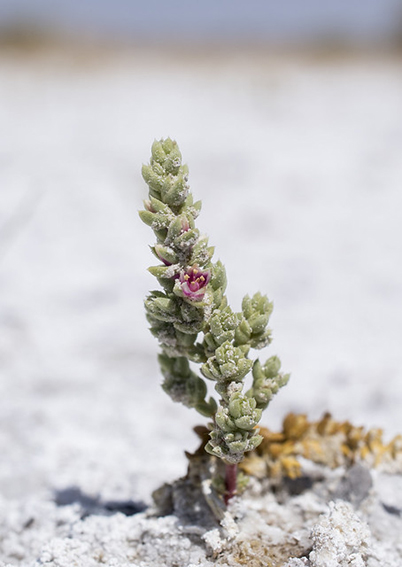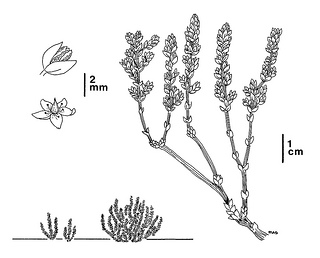(Nitrophila mohavensis)
 Nitrophila mohavensis. Photo (cc) Jeb Bjerke.
Nitrophila mohavensis. Photo (cc) Jeb Bjerke.
 Nitrophila mohavensis. CDFW illustration by Mary Ann Showers. (Click to enlarge)
Nitrophila mohavensis. CDFW illustration by Mary Ann Showers. (Click to enlarge)
Amargosa nitrophila is a California endangered plant species, which means that killing or possessing this plant is prohibited by the California Endangered Species Act (CESA). Amargosa nitrophila is also listed as endangered under the federal Endangered Species Act. Amargosa nitrophila is a small perennial herb that grows in colonies, with some individuals linked by extensive rhizomatous rootstocks. The species has leaves that appear somewhat succulent, and singular flowers that contain only sepals and appear from May to November. The species is endemic to the Ash Meadows region of the Mojave Desert, and the 2008 U. S. Fish and Wildlife Service 5-year Review (PDF) reports that there are only two known extant populations of Amargosa nitrophila in California and three known extant populations in Nevada. The largest number of Amargosa nitrophila plants occur at the Lower Carson Slough population in Inyo County, California.
Amargosa nitrophila is limited to wet, highly alkaline, salt-encrusted soils and is dependent upon both surface and subsurface hydrological features. Due to its specific habitat requirements, it is likely that the species range has always been restricted. Interruption of water supply is one of the biggest threats to Amargosa nitrophila, and may be difficult to detect due to normal variations in precipitation. Groundwater pumping may lower groundwater levels in Amargosa nitrophila habitat, threatening the species. Other significant threats include habitat loss due to surface mining, and habitat degradation from the improvement of Ash Meadows Road, which may alter sedimentation and flood patterns. Other potential threats include trampling by wild horses, off-highway vehicle use, invasive species, fire, a catastrophic flash flood, or catastrophic failure of the Crystal Spring Dam.
Amargosa nitrophila is included in the U.S. Fish and Wildlife Service’s ecosystem-based Recovery Plan for the Endangered and Threatened Species of Ash Meadows, Nevada (PDF). A long term population monitoring plan for Amargosa nitrophila should be prepared and implemented, along with a plan to monitor groundwater hydrology within Amargosa nitrophila habitat. Research into the hydrology of the Central and Lower Carson Slough is also needed. The risk to Amargosa nitrophila from a flash flood or failure of Crystal Spring Dam should be assessed and appropriate actions taken, and the potential for impacts to Amargosa nitrophila from the improvement of Ash Meadows Road should studied and addressed.
CDFW may issue permits for Amargosa nitrophila pursuant to CESA, and you can learn more about the California laws protecting Amargosa nitrophila and other California native plants. Populations of Amargosa nitrophila occur in CDFW’s Inland Desert Region. More information is also available from the U.S. Fish and Wildlife Service’s Species Profile for Amargosa nitrophila.
Updated 06/17/2013